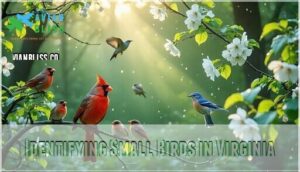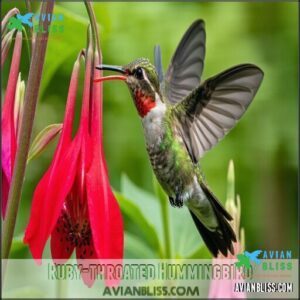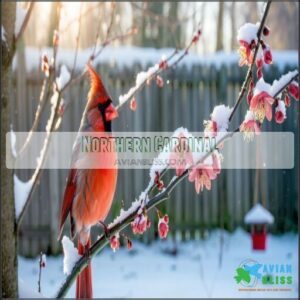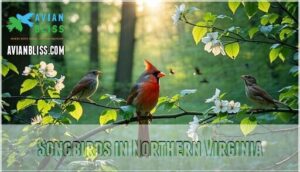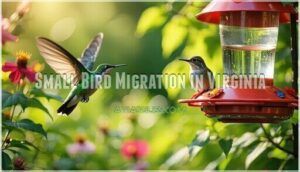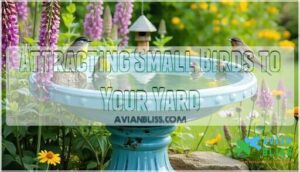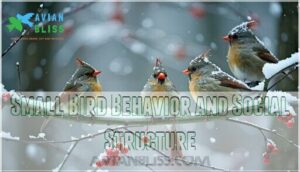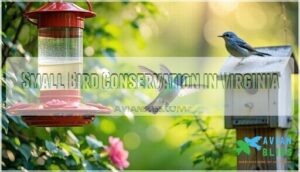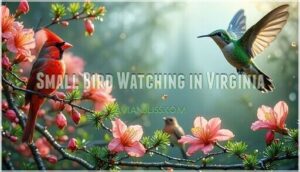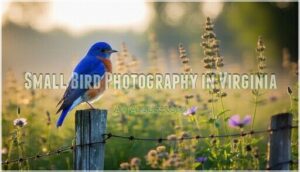This site is supported by our readers. We may earn a commission, at no cost to you, if you purchase through links.
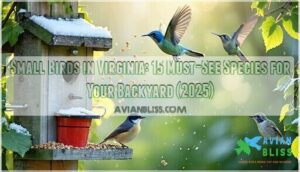
These tiny flyers thrive in Virginia’s diverse habitats, from coastal areas to mountain forests.
You can spot Northern Cardinals’ bright red plumage year-round, while colorful warblers pass through during spring and fall migrations.
Many small birds in Virginia will visit backyard feeders, especially during winter when natural food sources are scarce, and the right seed mix and water source can transform your yard into a bustling bird sanctuary where nature’s aerial show unfolds daily, making it a great place for backyard feeders.
Table Of Contents
- Key Takeaways
- Small Birds in Virginia
- Identifying Small Birds in Virginia
- Common Small Birds in Virginia
- Songbirds in Northern Virginia
- Small Bird Migration in Virginia
- Attracting Small Birds to Your Yard
- Small Bird Behavior and Social Structure
- Small Bird Conservation in Virginia
- Small Bird Watching in Virginia
- Small Bird Photography in Virginia
- Frequently Asked Questions (FAQs)
- What are the most common backyard birds in Virginia?
- Are there birds in Virginia?
- Where can you see birds in Virginia?
- What are some beautiful brown birds in Virginia?
- What birds live in Virginia in winter?
- How many types of birds are listed in Virginia?
- How Can I Identify Baby Birds Found on the Ground in Virginia?
- What Are the Largest Woodpeckers Spotted in Virginia and Where Are They Usually Found?
- What is the small brown bird in Virginia?
- How do I identify a bird in my yard?
- Conclusion
Key Takeaways
- You’ll find over 488 bird species in Virginia, including favorites like the Ruby-throated Hummingbird, Northern Cardinal, and Eastern Bluebird that bring color and activity to your backyard.
- Your backyard can become a bird sanctuary by planting native vegetation, installing appropriate feeders with black oil sunflower seeds and nyjer, and providing water sources that attract specific species.
- Virginia’s birds follow established migration patterns along the Atlantic Flyway, with many species arriving in spring and departing in fall, while some like the Northern Cardinal remain year-round.
- Small bird populations face threats from habitat loss, climate change, and pesticides, but you can help conservation efforts through habitat preservation, participating in citizen science projects, and creating bird-friendly spaces.
Small Birds in Virginia
You’ll find Virginia’s skies and trees filled with 488 bird species, including colorful favorites like the Ruby-throated Hummingbird, Northern Cardinal, and Eastern Bluebird.
From your own backyard, you can spot these small visitors year-round as they build nests, feed on seeds and insects, and bring natural beauty to your personal space.
Overview of Small Bird Species
A feathered tapestry of color and sound awaits you in Virginia’s diverse birdscape, home to an impressive 488 species.
The commonwealth’s small birds offer a perfect introduction to birdwatching with their accessible size and striking characteristics.
Among Virginia bird species, you’ll discover:
- Ruby-throated Hummingbirds weighing just 3.1g with iridescent plumage
- Northern Cardinals with their distinctive red coloration and crested heads
- Downy Woodpeckers measuring 6 inches with black-and-white spotted patterns
- Carolina Wrens featuring rich chestnut brown upperparts and musical calls
- Eastern Bluebirds sporting brilliant blue feathers and rusty-orange breasts
Size comparisons between species reveal fascinating adaptations, from specialized beak shapes to diverse vocalizations and nesting habits.
Habitat and Distribution
Virginia’s small birds make their homes in five distinct habitats.
Forest ecosystems shelter woodpeckers among regrowth of Eastern forests. Urban landscapes host adaptable species, while wetland areas provide water-rich environments.
Suburban gardens and rural woodlots create safe havens for priority species. Red-winged Blackbirds prefer rural and suburban settings over highly urbanized areas.
Each habitat offers unique features that support Virginia’s diverse native bird populations. Bird populations have seen marked declines in recent years.
Migration Patterns
Beyond where small birds live, you’ll see fascinating migration patterns throughout Virginia each year.
Birds move along well-established routes using remarkable navigation methods.
- Ruby-throated hummingbirds travel up to 2,000 miles to Central America, often crossing the Gulf of Mexico in a single flight!
- Small birds Virginia residents love, like goldfinches, make shorter regional movements
- Stopover habitats provide essential rest areas during spring and fall migration
- Climate impacts are changing traditional migration timing for many species
The Atlantic Flyway serves as a bird highway, with most following this path during their journeys.
Conservation Status
As birds fly their migration paths, they return to face serious challenges at home. Small birds in Virginia are experiencing alarming population declines, with warblers showing a 46% decrease since 1968. Habitat loss, climate change, and pesticide use create a perfect storm for our native birds.
You can join conservation efforts by:
- Planting native shrubs that provide natural shelter and food
- Eliminating pesticides in your yard that harm birds and their food sources
- Installing window decals to prevent collisions
- Participating in local bird monitoring programs
The Virginia Wildlife Action Plan identifies many species as needing protection. With 19 out of 28 shorebird species showing marked declines, habitat preservation matters more than ever.
Identifying Small Birds in Virginia
You’ll spot Virginia’s small birds more easily when you learn their distinct colors, shapes, and sounds.
With 488 bird species across the state, your backyard can become a birdwatching hotspot once you know what to look for.
Visual Identification Techniques
Spotting a tiny feathered friend requires keen observation.
Master these visual identification techniques to recognize small birds in Virginia:
| Feature | Look For | When to Observe |
|---|---|---|
| Beak Shapes | Seed-crackers vs. insect-catchers | Early morning |
| Color Markings | Wing bars, eye rings, crown patches | Full sunlight |
| Silhouette Outlines | Rounded vs. sleek profiles | Dawn/dusk |
Focus on plumage patterns, size comparison, and distinctive feather patterns for accurate identification, using techniques such as observing beak shapes and color markings to ensure a correct visual identification.
Bird Call Identification
Learning to identify small birds in Virginia by their calls adds a new dimension to your backyard birdwatching. Many species have distinctive call characteristics that make identification possible even when you can’t see them.
- The Carolina Wren’s tea-kettle, tea-kettle call fills gardens year-round
- Northern Cardinals whistle their clear "birdie, birdie, birdie" phrases
- Eastern Bluebirds produce soft, melodious warbling notes
- Tufted Titmice repeat their clear "peter-peter-peter" calls
Use recording techniques or bird sound apps to practice matching bird sounds to species variations.
Size and Shape Characteristics
Recognizing small birds in Virginia becomes easier when you focus on their distinct physical attributes.
Wing shapes range from rounded to pointed, while tail lengths vary from stubby to elongated.
Body mass helps classify tiny birds into categories – from the 3-gram Ruby-throated Hummingbird to the heftier 120-gram Northern Cardinal.
Beak morphology reveals feeding habits: thin for nectar, conical for seeds, or chisel-like for insects.
These size and shape characteristics create unique silhouettes that make common small birds instantly recognizable, even from a distance.
Plumage and Coloration
Beyond their size, plumage and coloration provide your most reliable clues for identifying Virginia’s small birds.
- Male Northern Cardinals flash brilliant crimson that’s impossible to miss
- Ruby-throated Hummingbirds display iridescent feathers that shimmer in sunlight
- Many sparrows use brown feather patterns as camouflage techniques
- Seasonal plumage changes can transform birds like the American Goldfinch
Color variations often reveal gender differences, with males typically showing more vibrant identifying markings than females.
Common Small Birds in Virginia
You’ll find Virginia’s yards host a rich variety of small birds, from the tiny Ruby-throated Hummingbird to the colorful Northern Cardinal.
These common backyard visitors include American Goldfinches, Eastern Bluebirds, and Tufted Titmice, all regularly seen at feeders throughout the state, which showcases the diverse array of birds in the area.
Ruby-throated Hummingbird
The Ruby-throated Hummingbird frequently captivates Virginia backyard watchers as the state’s sole breeding hummingbird species.
These tiny birds weigh just 3-4 grams, with males displaying their namesake iridescent ruby throat patch. Their wings beat 50-80 times per second, creating their distinctive humming sound.
During hummingbird migration, they travel incredible distances, even crossing the Gulf of Mexico.
They prefer nectar sources from tubular flowers and readily visit feeders filled with sugar water.
Their nesting habits include building walnut-sized nests on slender branches. To increase your chances of attracting hummingbirds, plant native flowers like cardinal flower and bee balm.
American Goldfinch
While our ruby-throated friends prefer nectar, the American Goldfinch stands out with its bright yellow summer plumage.
These small birds Virginia residents love watching are seed specialists.
The American Goldfinch demonstrates fascinating behaviors:
- Males transform from olive-drab winter colors to brilliant yellow in summer
- Their Dietary Preferences include almost exclusively seeds
- During the Molting Process, they change colors dramatically
- Their Social Behavior includes traveling in cheerful flocks
- Nesting Habits involve delaying breeding until midsummer
The behaviors of the American Goldfinch, including its Dietary Preferences, make it a unique and interesting bird to study.
Eastern Bluebird
While goldfinches dazzle with yellow plumage, the Eastern Bluebird captivates with its brilliant blue upperparts and rusty-orange chest.
This common Virginia bird thrives in open meadows with scattered trees.
Four key Eastern Bluebird facts:
- Males display rich admiral blue upperparts; females show grayish-blue wings and tail
- Their nest features an open cup shape containing 3-5 sky blue eggs
- They primarily eat insects and fruits, not seeds
- Their population once declined due to nesting hole shortages
Look for these small birds in Virginia’s suburban areas and parklands, where they can be spotted with their brilliant blue upperparts.
Northern Cardinal
Spotting the Northern Cardinal in your Virginia backyard is always a treat.
Males display brilliant red Cardinal Plumage, while females showcase subtle tan feathers with reddish accents.
Their distinctive Cardinal Song—a clear, whistling "what-cheer, cheer, cheer"—fills gardens year-round.
These common birds Virginia residents love prefer Cardinal Habitat of shrubby edges and dense vegetation for Cardinal Nesting.
Attract these songbirds with sunflower seeds, their favorite Cardinal Diet staple.
As one of the most recognizable small birds Virginia offers, Northern Cardinals remain faithful to their territories, bringing vibrant color to your backyard birds Virginia collection throughout the seasons.
Tufted Titmouse
The adorable Tufted Titmouse is one of Virginia’s most charming backyard residents, recognized by its mohawk-like crest and inquisitive personality.
- They feast primarily on insects during summer and seeds during winter
- Their whistling "peter-peter-peter" calls are unmistakable in Virginia forests
- They excavate tree cavities for nesting, often lining them with animal fur
- They lead mixed-species flocks during non-breeding season, partnering with Carolina Chickadees, which is a notable aspect of their social behavior.
Songbirds in Northern Virginia
You’ll find Northern Virginia’s forests and gardens filled with melodious songbirds including woodpeckers, warblers, sparrows, finches, and wrens.
These small birds create a natural symphony throughout the year, with species like the Northern Cardinal and Carolina Wren offering consistent songs even during winter months, making them a notable part of the area’s wildlife.
Woodpeckers
After admiring songbirds, you’ll discover eight remarkable woodpecker species in Northern Virginia’s forests and neighborhoods.
| Species | Key Characteristic |
|---|---|
| Downy Woodpecker | Smallest at 6 inches with spotted wings |
| Hairy Woodpecker | Larger look-alike with longer bill |
| Pileated Woodpecker | Crow-sized with dramatic red crest |
| Red-bellied Woodpecker | Zebra-backed with subtle red belly |
| Northern Flicker | Ground-feeding with spotted underside |
These woodpeckers maintain Virginia’s forest health through unique Drumming Behavior, varied Woodpecker Diets, and valuable Nesting Habits.
Warblers
While woodpeckers tap away at trees, warblers bring melodious sounds to Virginia’s mountains.
These colorful songbirds migrate through the state, with Yellow-rumped Warblers being winter visitors.
For successful warbler watching in Northern Virginia:
- Look for yellow patches on their rumps and crowns
- Listen for their distinctive "tseet" calls in oak and willow trees
- Visit during May when spring migration peaks
Oak and hickory trees attract insects that warblers love!
Sparrows
While warblers flit through Virginia’s treetops, sparrows carve out their own special place in the landscape.
You’ll find these year-round residents across Northern Virginia in diverse habitats.
| Sparrow Species | Habitat | Diet | Identification Tip |
|---|---|---|---|
| White-throated | Gardens | Seeds, insects | White throat patch |
| Song Sparrow | Wetland edges | Seeds, berries | Streaked breast with central spot |
| House Sparrow | Urban areas | Seeds, scraps | Males have gray crown, black bib |
| White-crowned | Brushy areas | Grains, insects | Bold striped head pattern |
These small birds Virginia residents love offer melodic sparrow songs and interesting sparrow identification challenges for backyard birders, with a chance to see their diverse habitats and enjoy their year-round presence.
Finches
Finches light up Virginia’s backyards with their colorful plumage and cheerful presence. As part of the songbird family, these seed-loving birds are relatively easy to attract and observe.
To enjoy finches in your yard:
- Install tube feeders filled with nyjer or sunflower seeds
- Plant native seed-producing flowers like coneflowers
- Provide fresh water sources year-round
- Create brushy areas for nesting materials
The American Goldfinch stands out with its bright yellow summer plumage, while House Finches display rosy hues. Purple Finches, though less common, offer a deeper wine-colored appearance. Their varied Finch Songs add delightful melodies to any garden, making them a wonderful addition with their cheerful presence and seed-loving nature.
Wrens
Discovering Virginia’s wrens offers year-round birding joy.
The Carolina Wren and House Wren thrive in Northern Virginia’s woodlands and gardens, recognized by their bold, bubbly songs and upturned tails.
These small birds in Virginia construct intricate nests in tree cavities and backyard nooks.
Their insect-heavy diet makes them valuable garden allies, while their curious nature makes wren identification in Virginia surprisingly simple.
Small Bird Migration in Virginia
You’ll witness Virginia’s amazing bird migration as numerous species follow the Atlantic Flyway, with Ruby-throated Hummingbirds making their remarkable journey from Central America each spring.
Your backyard can become a vital rest stop for these traveling birds, providing food and shelter as they move between their summer breeding grounds and winter homes, which is a crucial part of their remarkable journey.
Spring Migration Patterns
After watching Northern Virginia’s songbirds, you’ll notice small birds Virginia spring migration begins in April.
Warblers peak in early May, with up to 20 species visible in a single day!
Migratory birds Virginia take flight 30 minutes after sunset, with peak flyway congestion 2-3 hours later.
Finches and other species time their arrival timing with resource availability, ensuring breeding readiness despite potential climate impacts on their journey.
Fall Migration Patterns
During autumn, the Atlantic Flyway comes alive as small birds journey southward through Virginia.
Migration triggers like temperature drops send sparrows, finches, and warblers on their way, typically starting 30-45 minutes after sunset.
- Raptors and songbirds follow route variations through Virginia’s mountains
- Weather impacts create stopover ecology in places like the Great Dismal Swamp
- Climate change affects migration patterns, altering traditional timing
- Hawkwatch sites offer perfect spots to observe fall migration
For the best experience, visit mountain observation points where birds of prey glide along updrafts during their fall migration.
The Atlantic Flyway is a key route for many bird species, and understanding the impact of weather on their migration is crucial for conservation efforts.
Wintering Grounds
As winter settles in, Virginia’s Eastern Shore barrier islands become havens for small birds Virginia.
Winter visitors like Dark-eyed Juncos and American Tree Sparrows gather in these sanctuaries to survive winters.
Many non-migratory birds, such as cardinals, benefit from available winter habitat.
Four prime wintering grounds where you’ll observe roosting behavior include:
- Protected wildlife refuges offering predator avoidance
- Native plant-rich areas increasing food availability
- Dense conifer stands providing shelter from harsh elements
- Your own backyard feeders boosting survival rates
Notable Migration Routes
During spring and fall, Virginia serves as a vital junction on the Atlantic Flyway, where thousands of small birds travel between breeding grounds and wintering habitats.
The mountain region forms a natural corridor for warblers and songbirds, while Virginia’s coast provides essential stopover sites for shorebirds.
These habitat corridors, shaped by geography and vegetation patterns, guide migratory birds safely through their seasonal journeys between northern breeding grounds and southern wintering grounds.
Attracting Small Birds to Your Yard
You’ll transform your yard into a small bird paradise by adding native plants, reliable food sources, and sturdy feeders that match Virginia’s common species.
With the right setup and a bit of patience, you can attract everything from Ruby-throated Hummingbirds to Carolina Wrens right outside your window.
Planting Native Vegetation
Through native vegetation, you’ll create a thriving haven for Virginia’s small birds.
Plant Cardinal Flower, Virginia Sweetspire, and Eastern Redbud to provide natural food and shelter. Local nurseries offer region-specific varieties that support the ecosystem birds evolved with.
Sourcing native plants guarantees the best results for your garden.
Native plants require less maintenance while creating habitat connections. Your bird-friendly yard becomes part of a larger wildlife corridor, turning your garden into a sanctuary that small birds can’t resist visiting.
Providing Food Sources
Now that you’ve planted native vegetation, let’s talk food! Small birds in Virginia have specific preferences that’ll make your yard the neighborhood hot spot.
Choose the right seed types for your local visitors:
- Black oil sunflower seeds attract cardinals, titmice, and chickadees
- Nyjer seeds are irresistible to goldfinches and pine siskins
- Millet brings in sparrows, juncos, and doves
- Suet cakes provide essential winter feeding for woodpeckers and wrens
Proper feeder placement is key—position them near shrubs for quick escape routes. Consider using squirrel-proof feeders to keep food accessible for birds.
Don’t forget water sources like birdbaths or shallow dishes. Natural foods from berry bushes complement your feeding stations, creating a bird paradise.
Installing Bird Feeders
To transform your Virginia backyard into a bird sanctuary, choosing the right feeder makes all the difference.
Strategic feeder placement at eye level, away from predator hiding spots but near protective shrubs, creates a safe dining experience for your feathered visitors.
When selecting bird feeders in Virginia, match the style to your target species:
- Tube feeders with tiny perches attract finches and chickadees, perfect for Nyjer or sunflower seeds
- Platform feeders accommodate ground-feeding sparrows and juncos
- Suet cages beckon woodpeckers like the Downy and Red-headed varieties
Maintain proper feeder hygiene by cleaning weekly to prevent disease spread among small birds in Virginia. Consider squirrel deterrents like baffles or weight-sensitive feeders to guarantee your seed selection reaches intended diners.
Many prefer specialized feeder products for ideal bird attraction. Most Virginia species prefer black oil sunflower seeds, but offering a variety will attract the widest range of colorful visitors.
Creating Bird-Friendly Habitats
Beyond feeders, your yard can become a bird haven with these simple elements:
Mix shelter options with nesting sites in your birdfriendly yard.
Place feeders near shrubs where birds can quickly escape predators.
Virginia’s backyard birds love layered habitats with native plants at different heights, creating their perfect neighborhood.
Small Bird Behavior and Social Structure
You’ll witness fascinating social patterns when observing Virginia’s small birds in your backyard, from the territorial singing of Northern Cardinals to the cooperative winter flocking of chickadees and titmice.
The complex behaviors of these tiny backyard visitors include specific breeding rituals, distinct communication methods, and seasonal changes in social structure that directly affect when and how you’ll spot them at your feeders, which is influenced by their cooperative winter flocking.
Flocking Behavior
After setting up your feeder, you’ll witness fascinating flocking behavior among Virginia’s small birds.
When birds gather in groups, they’re not just being social—they’re using survival strategies.
Watch how they work together:
- Predator avoidance: More eyes mean earlier detection of hawks
- Foraging benefits: Birds share information about food sources
- Social hierarchy: Notice how certain species take turns at feeders
This flock dynamics showcase how tiny birds maximize safety through collective wisdom.
Mating and Breeding Habits
While flocks disperse in spring, Virginia’s small birds begin their intimate courtship rituals.
Watch males perform elaborate displays to attract mates through colorful plumage and melodious songs.
| Species | Nesting Behavior | Parental Care |
|---|---|---|
| Cardinal | Shrub nests, 2-5 eggs | Both parents feed |
| Bluebird | Cavity nester, 4-6 eggs | Males bring food |
| Goldfinch | Late breeders (July) | Female incubates |
| Wren | Bulky stick nests | Highly territorial |
| Hummingbird | Tiny cup nests | Female-only care |
After pairing, most songbirds share responsibilities from egg-laying through chick development, though patterns vary widely among Virginia’s small birds, with elaborate displays and colorful plumage being key factors, and melodious songs also playing a role in their courtship rituals.
Territorial Behavior
After the courtship dance comes the serious business of home defense.
Virginia’s small birds showcase fascinating territorial behavior through:
- Defense strategies using aerial displays
- Song duels that warn rivals away
- Resource competition for the best feeding spots
- Nesting boundaries marked by scent and song
- Dominance displays like chest-puffing and wing-spreading
Even tiny songbirds in Virginia fiercely protect their patch against neighbors, with Northern Cardinals and Carolina Wrens being particularly bold defenders.
Communication Methods
Virginia’s small birds communicate through a rich tapestry of sounds and movements.
Listen carefully to decipher their secret language.
Birds also use elaborate visual displays to communicate intentions.
| Communication Method | Purpose | Example Species | Sound Description | When to Observe |
|---|---|---|---|---|
| Alarm Calls | Danger warning | Tufted Titmouse | Sharp "peter-peter" | When predators approach |
| Courtship Songs | Attraction | Northern Cardinal | Melodic whistles | Spring mornings |
| Contact Calls | Location tracking | Carolina Wren | "tea-kettle" | Throughout day |
| Territorial Claims | Boundary marking | American Goldfinch | Warbling phrases | Dawn and dusk |
| Mimicry Skills | Social learning | Eastern Bluebird | Gentle warbles | Year-round |
The table above outlines various communication methods used by birds, including alarm calls, courtship songs, and territorial claims.
These methods are crucial for the birds’ survival and social interactions.
Small Bird Conservation in Virginia
You’ll help Virginia’s small birds thrive by learning about the threats they face and the steps you can take to protect them.
Your backyard can become a essential sanctuary for the 488 bird species that call Virginia home, including favorites like the Ruby-throated Hummingbird and Eastern Bluebird.
Threats to Small Bird Populations
After watching birds interact in complex social groups, you might be surprised to learn what threatens them.
Small birds in Virginia face five major challenges: habitat loss from urbanization, climate change disrupting migration patterns, pesticide use reducing food sources, invasive species competing for resources, and window strikes causing countless deaths.
These threats combine to create significant population declines, particularly for specialized species that can’t easily adapt to changing environments.
Addressing these issues requires collaborative conservation efforts to guarantee their survival, such as those found through collaborative conservation efforts.
Conservation Efforts
How are Virginia’s small birds being protected from growing threats?
Several significant conservation efforts are underway across the state.
- The Virginia Grassland Bird Initiative works with farmers and landowners to create resilient ecosystems that benefit declining grassland species in the Piedmont and Shenandoah Valley regions.
- Community science programs through eBird increase monitoring capacity at protected properties, allowing everyday bird enthusiasts to contribute valuable data to conservation efforts.
Habitat Preservation
Beyond protecting small birds through advocacy, preserving their natural homes is where you’ll make the biggest difference.
Native Planting creates essential forest habitats right in your yard.
Support wetland protection and rural preservation while incorporating native plants in suburban planning—your backyard can become a pivotal sanctuary for Virginia’s small birds.
Research and Monitoring
How do scientists track Virginia’s smallest flyers? Research and monitoring are the backbone of small bird conservation efforts.
You can contribute to this important work through:
- Joining citizen science projects that track population trends
- Participating in annual bird counts to identify that small brown bird in your yard
- Using tracking technology to help understand habitat impact
Your observations provide valuable data for analysis, helping researchers understand why some species thrive while others decline. This information guides preservation strategies, ensuring our feathered neighbors continue to brighten Virginia’s skies for generations to come, which is crucial for small bird conservation.
Small Bird Watching in Virginia
You’ll find Virginia’s small birds at various hotspots where 488 species gather throughout the year, including state parks, wildlife refuges, and your own backyard.
With the right equipment and timing, you can observe colorful cardinals, ruby-throated hummingbirds, and yellow-rumped warblers going about their daily activities.
Best Birding Locations
While protecting our feathered friends remains essential, exploring where to find them is just as rewarding.
Virginia offers spectacular birding locations for spotting your favorite small birds:
- Dutch Gap Conservation Area provides diverse habitats ranked among Virginia’s best birding sites
- Shenandoah National Park features 79 highly-rated bird watching trails
- Huntley Meadows Park offers free wetland boardwalks near Alexandria
- Chincoteague National Wildlife Refuge attracts numerous coastal species along the Atlantic Flyway
This provides a variety of birding sites for enthusiasts to enjoy.
Birding Tours and Guides
Now that you’ve explored Virginia’s best birding spots, consider joining professional birding tours to enhance your experience.
Local guides with deep expertise can help you spot elusive small birds Virginia residents love. Tour types range from casual morning walks to intensive weekend expeditions.
You’ll learn ethical birding practices while guides share identification tips for those tricky species. The tour benefits extend beyond just sightings—you’ll gain knowledge that improves your independent birding adventures.
Most companies offer booking tips on their websites.
Birding Festivals and Events
Virginia’s 2025 birding festivals connect you with small birds through guided walks and conservation booths.
Mark your calendar for the Virginia Osprey Festival (April 12), Virginia Birding Classic (April 15-May 15), and Great Dismal Swamp Birding Festival (April 26).
These festival locations offer bird identification Virginia workshops and family activities.
Check event schedules at each venue for birding tours featuring Virginia’s smallest feathered residents.
Small Bird Photography in Virginia
You’ll find Virginia’s small birds make perfect photography subjects with their vibrant colors and unique behaviors.
From the tiny Ruby-throated Hummingbird to the striking Eastern Bluebird, capturing these feathered residents requires patience and the right camera settings, which involves understanding their unique behaviors.
Tips for Capturing Small Birds
Now that you’ve spotted Virginia’s fascinating birds, let’s capture those fleeting moments. Photography helps you remember these special encounters long after the birds have flown.
To photograph small birds successfully, you’ll need patience and understanding of bird behavior. Birds are most active during early morning hours when lighting is soft and golden.
- Setting up near feeders gives you predictable shooting locations where Virginia’s small birds gather
- Moving slowly and wearing neutral colors helps you blend into the environment
- Using a blind or shooting from inside your car works wonders for shy species
- Learning common perch locations lets you pre-focus your camera
- Watching for behavior patterns helps you anticipate perfect photo moments
Remember, patience pays off when photographing these delicate creatures. The joy of capturing a Carolina Wren’s curious expression or a Ruby-throated Hummingbird’s iridescent feathers makes the wait worthwhile.
Camera Equipment and Settings
Now that you know what to look for, let’s gear up! For capturing small birds in Virginia, a mirrorless camera like the Sony Alpha 1 or OM System OM-1 Mark II works wonders.
Pair it with a telephoto lens (at least 300mm). For Sony Alpha 1 accessories, consider browsing online retailers.
Zoom Lens
Image Stabilization
Set your shutter speed fast to freeze those quick wings!
Photography Techniques
The perfect bird photograph requires patience and proper technique.
Capture Virginia’s small birds with these essential approaches:
- Position yourself downwind to avoid startling skittish species
- Use burst mode to catch quick movements when birds take flight
- Frame shots with natural elements to provide environmental context
- Practice panning techniques to follow birds in motion
Shoot during golden hours when lighting conditions are soft and flattering. Adjust your camera settings for faster shutter speeds (1/1000+) to freeze wing movements.
Remember, understanding bird behavior helps you anticipate the perfect moment. Employing the rule of thirds can also substantially improve your shots.
Editing and Post-Processing
Now that you’ve captured your flying jewels, it’s time for post-processing magic. Start with gentle image cropping to frame your subjects perfectly.
Apply color correction to make Virginia’s small birds pop while keeping colors natural. Reduce noise in those early morning shots, then add subtle sharpening to highlight fine feather details.
Don’t forget metadata management—tag species names for your growing identification guide of common small birds.
Frequently Asked Questions (FAQs)
What are the most common backyard birds in Virginia?
In your backyard bird soap opera, you’ll find Northern Cardinals stealing the spotlight.
Along with Carolina Wrens, American Robins, Blue Jays, Tufted Titmice, and Downy Woodpeckers making regular appearances in Virginia.
Are there birds in Virginia?
Yes, Virginia is home to 488 bird species. You’ll find cardinals, bluebirds, woodpeckers, and hummingbirds throughout the state. They’re frequently spotted at feeders and in natural habitats year-round.
Where can you see birds in Virginia?
Like tiny treasures in a vast forest, birds in Virginia can be spotted in national parks, state forests, backyard feeders, wetlands, suburban gardens, and along the Chesapeake Bay.
You’ll find them everywhere you look.
What are some beautiful brown birds in Virginia?
In Virginia, you’ll spot beautiful brown birds including Carolina Wrens with their rich chestnut plumage, Song Sparrows with streaked patterns, and White-throated Sparrows featuring distinctive white markings.
Each brings unique charm to your backyard.
What birds live in Virginia in winter?
Birds of a feather flock together" in winter Virginia. You’ll find Northern Cardinals, Blue Jays, American Goldfinches, White-throated Sparrows, Yellow-rumped Warblers, and Ruby-crowned Kinglets braving the cold months.
How many types of birds are listed in Virginia?
According to available information, you’ll find 488 different bird species throughout Virginia. These range from common backyard visitors like cardinals to seasonal migrants and rare woodland inhabitants.
How Can I Identify Baby Birds Found on the Ground in Virginia?
Tiny feathered mysteries on the ground need careful observation.
Look for beaks, emerging feathers, and coloration patterns. Use a field guide to compare features with common Virginia nestlings.
Don’t touch unless necessary, and remember to preserve the natural state of the nestlings for their well-being.
What Are the Largest Woodpeckers Spotted in Virginia and Where Are They Usually Found?
You’ll find Pileated Woodpeckers, the largest in Virginia at 19 inches long, in forests throughout the state.
They’re crow-sized with striking red crests, and you can spot them in Shenandoah National Park.
What is the small brown bird in Virginia?
You’re likely spotting the Carolina Wren in Virginia. This small brown bird has chestnut upperparts, creamy underparts, and visits backyard feeders year-round. They’ve got a distinctive high-pitched whinnying call.
How do I identify a bird in my yard?
You’ll need binoculars, a field guide, and patience.
Watch for size, color patterns, behavior, and listen to calls.
Take photos when possible, and consider using Cornell’s Merlin Bird ID app to help identify your feathered visitors.
Conclusion
Ultimately, the small birds in Virginia offer a window into nature’s wonders right in your backyard.
You’ll find these feathered friends bring joy quicker than greased lightning when you provide the right habitat and food.
By hanging diverse feeders and planting native shrubs, you’re creating a haven for these remarkable creatures.
Whether you’re a seasoned birder or just starting out, Virginia’s small birds will reward your efforts with their vibrant colors, cheerful songs, and fascinating behaviors.
- https://www.audubon.org/field-guide/bird/carolina-wren
- https://loudounwildlife.org/2019/11/tufted-titmice-are-charming-year-round-neighbors/
- https://www.bbc.com/future/article/20191211-crows-could-be-the-smartest-animal-other-than-primates
- https://www.youtube.com/birdwatchinghq
- https://www.whro.org/environment/2025-03-20/virginia-birds-are-suffering-steep-declines-alongside-national-trend

